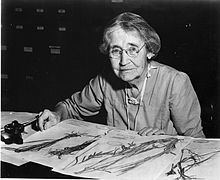Other names Agnes Chase Spouse William Ingraham Chase Nationality American Name Mary Chase | Known for First Book of Grasses Role Botanist Author abbrev. (botany) | |
 | ||
Born April 29, 1869Iroquois County, Illinois ( 1869-04-29 ) Died September 24, 1963, Bethesda, Maryland, United States Books First book of grasses, Old and New Plant Lore: A Symposium Fields Botany, Botanical illustration | ||
Carolyn sheffield from the smithsonian shows us mary agnes chase s field books
Mary Agnes Meara Chase (April 29, 1869 – September 24, 1963) was an American botanist who worked at the U.S. Department of Agriculture and the Smithsonian Institution. She is "considered one of the world's outstanding agrostologists" and is known for her work on the study of grasses and for her work as a suffragist.
Contents
- Carolyn sheffield from the smithsonian shows us mary agnes chase s field books
- Life and career
- Womens Suffrage Movement
- Awards and honors
- Selected works
- Eponyms
- References
Life and career
Chase was born in Iroquois County, Illinois and held no formal education beyond grammar school. Chase made significant contributions to the field of botany, authored over 70 scientific publications, and was conferred with an honorary doctorate in science from the University of Illinois. She specialized in the study of grasses and conducted extensive field work in North and South America. Her field books from 1897 to 1959 are archived in the Smithsonian Institution Archives.
In 1893, Mary had visited the Colombian Exposition in Chicago with her nephew, who was a botanist, and this had inspired her to study plants in Northern Illinois. In 1901, Chase became a botanical assistant at the Field Museum of Natural History under Charles Frederick Millspaugh, where her work was featured in two museum publications: Plantae Utowanae (1900) and Plantae Yucatanae (1904). Two years later, Chase joined the U.S. Department of Agriculture (USDA) as a botanical illustrator and eventually became a scientific assistant in systematic agrostology (1907), assistant botanist (1923), and associate botanist (1925), all under Albert Spear Hitchcock. Chase worked with Hitchcock for almost twenty years, collaborating closely and also publishing (The North American Species of Panicum [1910]).
Following Hitchcock's death in 1936, Chase succeeded him to become senior botanist in charge of systematic agrostology and custodian of the Section of Grasses, Division of Plants at the United States National Museum (USNM). Chase retired from the USDA in 1939 but continued her work as custodian of the USNM grass herbarium until her death in 1963.
Women's Suffrage Movement
Chase experienced discrimination based on her gender in the scientific field, for example, being excluded from expeditions to Panama in 1911 and 1912 because the expedition's benefactors feared the presence of women researchers would distract men. During World War I, Chase marched with Alice Paul and was jailed several times for her activities. In 1918, she was arrested at the Silent Sentinels rally picketing the White House; she refused bail and was held for 10 days, where she instigated a hunger-strike and was force-fed. The USDA accused her of "conduct unbecoming a government employee," but Hitchcock helped her keep her job.
Chase was also an active member of the National Association for the Advancement of Colored People (NAACP).
